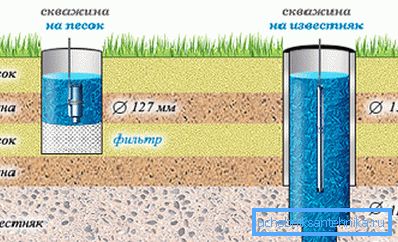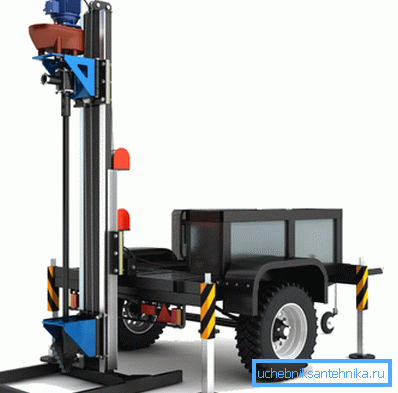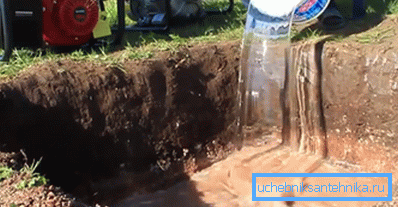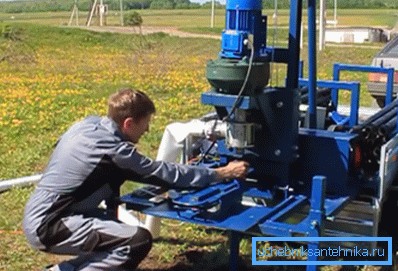How to drill a well with your hands with water
We suggest you learn how to drill a well manually in a lightweight way, using water as your ally and helper. Of course, we are not talking about full manual labor, because with a single shovel or a hand drill it is simply unrealistic to mount such an arrangement, and we live in the 21st century, at the height of the technical revolution.
Below we will talk about the features of such production, as well as, as additional material, see the thematic video in this article.

Hydraulic drilling
Note. According to the law of the Russian Federation On Subsoil of February 21, 1992, as amended on December 28, 2013, artesian waters are state property, therefore, a license is needed for such developments, which is not very easy to obtain. In this regard, the question of which well to drill for the house is resolved by itself - in suburban areas, as a rule, wells are drilled on sand, the depth of which does not exceed 50 m.
Depth

- First of all, any owner will be interested in the question, and how to find out how deep a well is to be drilled, but given that these parameters will be different for each locality, there are no exact figures, but there are proven methods.
- The first method is the easiest - ask the neighbors in the area who have already done this before (if they have good water), while the second method involves drilling with constant samples of the aquifer.
- Of course, the second method is more time consuming and expensive, but you will be confident in the quality of the drinking water you use, but it can also be said about general (average) measurements.
- The upper aquifer is found already at a depth of 4 to 6m, but if you decide to stop at this, then chemical laboratory analysis is mandatory, as there is a very high risk of various harmful substances entering. But such depth is practically not used for wells and even for wells is used only in exceptional cases.
- The next aquifer is at a distance of 10-18 m from the surface of the earth and, as a rule, is suitable for food consumption. But there may be exceptions, then you have to drill to a depth of 25 to 40 m or even 50 m to get to clean water. In any of the above options, this will be a hole in the sand, where both the price and labor costs are much less than for the artesian.
Getting Started

For work in our case, you should use a small-sized drilling rig (MBU) of any brand, motor-pump and generator. All this can be rented or bought if you decide to drill at a professional level..

First of all, we will need to dig a water pit that should contain more than 2 m3, that is, with a margin. Near it, in the immediate vicinity, it is necessary to assemble the MBU - this will take no more than 15-20 minutes together with the connection, and screw the expansion feet on the sides for the stability of the unit during operation (protection from vibration). From the pit to the point of drilling a shallow groove of the message is dug out for the circulation of fluid in the process of work, as the instruction requires.
In the excavated pit we fill in a cube of water (this will be enough for the whole process) and connect the hoses to the MBU and the motor pump. We wind the suction hose onto the lower thread, and lower its other end with the filter wound in advance into the pit, but so that it does not touch the bottom. We wind the other sleeve from above, connecting the other end to the swivel to supply water to the well.

In continuation of the topic of how to drill a well, we need to center the drill and for this we lift the carriage with a hoist and wind it on the shaft of the swivel. Now we drop everything down so that the tip rests on the ground, and carefully unscrew the drill, leaving it in place. Now it remains for us to insert (screw) in the gap bar, and you can get to work.
Recommendation. Do not forget that you will need to lower into the production pipe a submersible pump, the diameter of which must be less than the casing section. Therefore, at this stage, it is important to consider the diameter of the well, which will depend on the drill blades.

When everything is collected, centered and connected, you can begin the process, the duration of which will depend on the density of the soil. Depending on this indicator, you can use cutting and roller bits or even add abrasive elements to water in the form of coarse sand or steel shot.
Such additions are needed exclusively for hard rocks, but in any case, you need to use a mud pump to ensure that the fluid is permeable.
After that, when the carriage with all the devices falls almost to the surface of the earth, you need to unscrew the barbell from the shaft of the swivel again, lift it upwards and screw the other bar into the gap with your own hands.
This process (adding inserts) will be repeated until you reach the desired depth (it can be determined by the number of inserts). Watch the amount of liquid in the pit, because it will be absorbed into the soil, therefore, from time to time, add water, maintaining the volume in the amount of one cube.
Conclusion
The advantage of hydroburning over other methods is obvious - you have minimal labor costs and relatively low production costs. Judge for yourself, because in this situation you will have to pay only the rental of equipment and fuel for the motor-pump, but otherwise the whole process depends on your participation, which is not so great. That is, basically your job is to observe the mechanisms and the process itself.